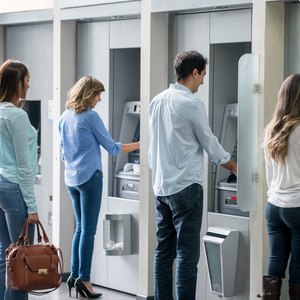
The dark line on the back of your ATM card is a magnetic strip that contains identifying details about the card and its owner. Each time you swipe the card through an ATM or card reader, the machine checks the data from the stripe with a verification company before it completes the transaction. It's sometimes difficult to swipe an ATM card effectively, but you can fix the problem with one of several techniques. If the problem occurs frequently, it's a sign that the stripe is wearing down and becoming demagnetized. At this point, it's best to contact your financial institution to request a new card.
Possible Causes and Prevention
If you're having problems swiping your card, check the card for dust, dirt or lint. This is a possible problem if you store your card loosely in your purse, wallet or pocket. Any debris on the strip can interfere with the process of reading the delicate magnetic strip. Wipe the back of the card clean on a piece of cloth or on your clothing before swiping it through the card reader. Cell phones and other cards with magnetized strips can also demagnetize your ATM card.
When you go to your bank to have your card replaced, ask them to provide you with an ATM card sleeve. Keeping your ATM card in a sleeve protects it from scratches, dust and debris. Some financial institutions send these sleeves with new cards, but ask to make sure and if not, request one.
Possible Solutions
You may notice a checker will sometimes use a plastic bag to cover the strip on a card that isn't working properly. This masks errors because scratches, dirt and exposure to magnets – such as from the clasps on a purse – affect the arrangement of the magnetic bars on the strip. The scanner can overlook slight errors when it's covered. Slip the card into a plastic bag, hold the bag taut around the card so there are no wrinkles and slide it through the card reader. You could also cover the card with paper, like a receipt, or masking tape.
Next, you or the checker has to slide the card quickly through the card reader or ATM. The machines are programmed to scan the strip at a particular speed, which is why most of them advise the customer to insert and remove the card quickly. They are unable to read the information if you slide your card at a slower rate. Note that some machines, like ATMs that retain the card until the transaction is complete, might not have allowance for the plastic covering. If this doesn't work, ask the checker to manually enter your card information to complete the transaction.
References
- Discover: Surprising Reasons Your Credit Card Won’t Swipe
- Mental Floss: How Does a Plastic Bag Fix a Buggy Credit Card?
- Discover. "What Is a Credit Card Number?" Accessed March 13, 2020.
- Federal Trade Commission. "What to Know About the New Credit and Debit Chip Cards." Accessed March 13, 2020.
- Discover. "Surprising Reasons Your Credit Card Won't Swipe." Accessed March 13, 2020.
- National Center for Biotechnology Information. "Design, Fabrication and Characterization of Computer Generated Holograms for Anti-Counterfeiting Applications Using OAM Beams As Light Decoders." Accessed March 13, 2020.
- Experian. "What Is a CVV Number on a Credit Card?" Accessed March 13, 2020.
Tips
- Some banks will replace your damaged ATM card the same day if you take it into a branch. Keep your ATM card in a sleeve to protect it from scratches, dust and debris. Some financial institutions send these sleeves with new cards.
Warnings
- Cell phones and other cards with magnetized strips can demagnetize your ATM card.
Writer Bio
Tina Amo has been writing business-related content since 2006. Her articles appear on various well-known websites. Amo holds a Bachelor of Science in business administration with a concentration in information systems.

